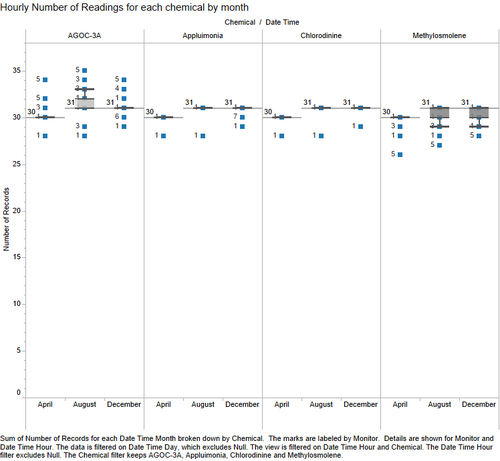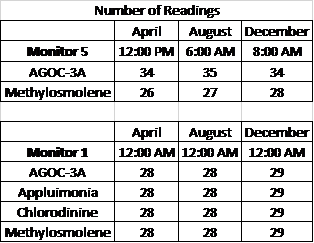Difference between revisions of "ISSS608 2016-17 T3 Assign ASMIT ADGAONKAR"
Asmita.2016 (talk | contribs) |
Asmita.2016 (talk | contribs) |
||
| Line 9: | Line 9: | ||
A further investigation for this matter can be demanded to analyze the sensor logs and understand the manner in which sensors are designed to collect readings. Wind speed and wind direction can also be looked at these times to see if that has any influence on this flaw of sensor operation. | A further investigation for this matter can be demanded to analyze the sensor logs and understand the manner in which sensors are designed to collect readings. Wind speed and wind direction can also be looked at these times to see if that has any influence on this flaw of sensor operation. | ||
Last but not the least, this particular behavior of showing overweight on AGOC and underweight on Methylosmolene should also portrayed on the big picture of whether the companies are any reason behind the tampering of the readings. Are these companies tampering the sensor to stay in compliance of the pollutant readings? | Last but not the least, this particular behavior of showing overweight on AGOC and underweight on Methylosmolene should also portrayed on the big picture of whether the companies are any reason behind the tampering of the readings. Are these companies tampering the sensor to stay in compliance of the pollutant readings? | ||
| + | |||
| + | [[File:Q1table.png| 500px]] | ||
| + | |||
| + | Similarly, it can be seen that Monitor#1 has failed to capture readings at midnight for all the chemicals for atleast 2-3 days in each of the months. It would be worth investigating if this is due to some sort of maintenance activity for the sensors or is there a genuine flaw in the operations there. | ||
| + | |||
| + | On similar lines, a quick bubble chart for each of the 3 months involving the readings of all the monitors tell us that readings/pollutants have increased gradually from April to December. | ||
| + | However, special mention goes to sensor #4 which has increased significantly with the passage of time. It would be worth investigating if sensor 4 had any issues in April or whether it is largely influenced by wind speed and direction flowing in the line of the sensor. | ||
Revision as of 21:48, 7 July 2017
MC2.1 – Characterize the sensors’ performance and operation. Are they all working properly at all times? Can you detect any unexpected behaviours of the sensors through analysing the readings they capture? Limit your response to no more than 9 images and 1000 words.
With the help of a boxplot of the hourly number of readings for each chemical each month, we can see a pattern in the aberration of sensor performance and operations.
It can be seen that Monitor# 5 has failed to collect readings for Methylosmolene at 12 pm in April, 6 am in August and at 8 am in December. In contrast, the monitor has actually gone on to record those numbers and assign it to AGOC-3A chemical. A further investigation for this matter can be demanded to analyze the sensor logs and understand the manner in which sensors are designed to collect readings. Wind speed and wind direction can also be looked at these times to see if that has any influence on this flaw of sensor operation. Last but not the least, this particular behavior of showing overweight on AGOC and underweight on Methylosmolene should also portrayed on the big picture of whether the companies are any reason behind the tampering of the readings. Are these companies tampering the sensor to stay in compliance of the pollutant readings?
Similarly, it can be seen that Monitor#1 has failed to capture readings at midnight for all the chemicals for atleast 2-3 days in each of the months. It would be worth investigating if this is due to some sort of maintenance activity for the sensors or is there a genuine flaw in the operations there.
On similar lines, a quick bubble chart for each of the 3 months involving the readings of all the monitors tell us that readings/pollutants have increased gradually from April to December. However, special mention goes to sensor #4 which has increased significantly with the passage of time. It would be worth investigating if sensor 4 had any issues in April or whether it is largely influenced by wind speed and direction flowing in the line of the sensor.

